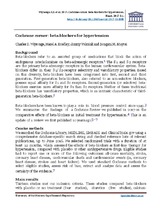| dc.contributor.author | Wiysonge, Charles S. | |
| dc.contributor.author | Bradley, Hazel A. | |
| dc.contributor.author | Volmink, Jimmy | |
| dc.contributor.author | Mayosi, Bongani M. | |
| dc.date.accessioned | 2018-09-03T11:59:56Z | |
| dc.date.available | 2018-09-03T11:59:56Z | |
| dc.date.issued | 2017 | |
| dc.identifier.citation | Wiysonge, C.S. et al. 2017. Cochrane corner: beta-blockers for hypertension. Heart, 2017 0:1. | en_US |
| dc.identifier.uri | http://dx.doi.org/10.1136/heartjnl-2017-311585 | |
| dc.identifier.uri | http://hdl.handle.net/10566/3995 | |
| dc.description.abstract | Beta-blockers refer to an assorted group of medications that block the action of endogenous catecholamines on beta-adrenergic receptors.1 The ß1 and ß2 receptorsare the primary beta-adrenergic receptors in the human cardiovascular system. Beta- blockers differ in their ß1/ ß2-receptor selectivity and vasodilatory properties. Based on this diversity, beta-blockers have been categorised into first, second and third generation. First-generation beta-blockers, also referred to as non-selective blockers, possess equal affinity for ß1 and ß2 receptors. Second-generation (or selective) beta-blockers exercise more affinity for ß1 than ß2 receptors. Neither of these traditional beta-blockers has vasodilatory properties, which is an intrinsic characteristic of third-generation beta-blockers. | en_US |
| dc.language.iso | en | en_US |
| dc.publisher | BMJ Publishing Group | en_US |
| dc.rights | This is the author-version of the article published online at: http://dx.doi.org/10.1136/heartjnl-2017-311585 | |
| dc.subject | Beta-blockers | en_US |
| dc.subject | Hypertension | en_US |
| dc.subject | Endogenous catecholamines | en_US |
| dc.subject | Beta-adrenergic receptors | en_US |
| dc.title | Cochrane corner: beta-blockers for hypertension | en_US |
| dc.type | Article | en_US |
| dc.privacy.showsubmitter | FALSE | |
| dc.status.ispeerreviewed | TRUE | |
| dc.description.accreditation | ISI | |

